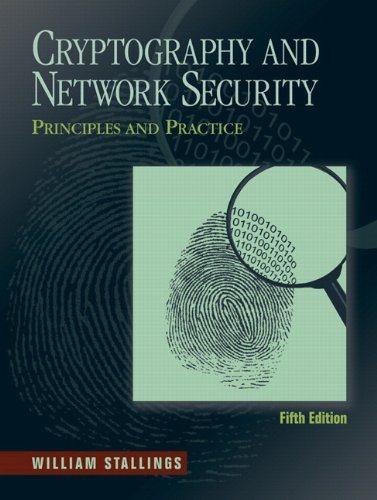This is a very interesting case, Watson, Holmes said. The young man loves a girl, and she
Question:
"This is a very interesting case, Watson," Holmes said. "The young man loves a girl, and she loves him too. However, her father is a strange fellow who insists that his would-be son-in-law must design a simple and secure protocol for an appropriate public-key cryptosystem he could use in his company's computer network. The young man came up with the following protocol for communication between two parties. For example, user A wishing to send message \(M\) to user B: (messages exchanged are in the format sender's name, text, receiver's name)"
1. A sends \(\mathrm{B}\) the following block: \(\left(A, \mathrm{E}\left(P U_{b},[M, A]ight), Bight)\).
2. \(\mathrm{B}\) acknowledges receipt by sending to \(\mathrm{A}\) the following block: \(\left(B, \mathrm{E}\left(P U_{a},[M, B]ight), Aight)\). "You can see that the protocol is really simple. But the girl's father claims that the young man has not satisfied his call for a simple protocol, because the proposal contains a certain redundancy and can be further simplified to the following:"
1. A sends B the block: \(\left(A, \mathrm{E}\left(P U_{b}, Might), Bight)\).
2. B acknowledges receipt by sending to \(\mathrm{A}\) the block: \(\left(B, \mathrm{E}\left(P U_{a}, Might), Aight)\).
"On the basis of that, the girl's father refuses to allow his daughter to marry the young man, thus making them both unhappy. The young man was just here to ask me for help."
"Hmm, I don't see how you can help him." Watson was visibly unhappy with the idea that the sympathetic young man has to lose his love.
"Well, I think I could help. You know, Watson, redundancy is sometimes good to ensure the security of protocol. Thus, the simplification the girl's father has proposed could make the new protocol vulnerable to an attack the original protocol was able to resist," mused Holmes. "Yes, it is so, Watson. Look, all an adversary needs is to be one of the users of the network and to be able to intercept messages exchanged between A and B. Being a user of the network, he has his own public encryption key and is able to send his own messages to \(A\) or to \(B\) and to receive theirs. With the help of the simplified protocol, he could then obtain message \(M\) user A has previously sent to B using the following procedure:"
\section*{Complete the description.}
Step by Step Answer:






